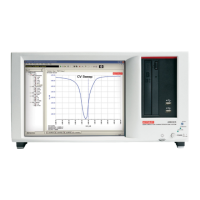4200-900-01 Rev. K / February 2017 Return to Section Topics 1-31
Model 4200-SCS User’s Manual Section 1: Getting Started
Average type (acquisition)
There are four waveform acquisition types that can be set for the scope: Normal, average,
envelope, or equivalent time:
Normal: In normal mode, a single waveform is captured.
Average: In average mode, multiple captured waveforms are averaged.
Envelope: In envelope mode, the minimum and maximum waveform points from multiple
acquisitions are combined to form a waveform (an envelope) that shows min/max changes over
time.
Equivalent time: In equivalent time mode, a picture of a repetitive waveform is constructed by
capturing a small amount of information from each repetition. Because the points appear randomly
along the waveform, it is important to note that an entire waveform may not be constructed unless
there are sufficient repetitions. Unfilled points will be constructed using a zero-order hold and are
flagged with a “1” in the least significant bit (LSB) of the 16-bit waveform code. Also, the number of
points per point can be set using average equivalent time points to increase the resolution of the
waveform.
Average equivalent time points
When using the equivalent time acquisition mode, the number of user-defined points per point for
equivalent time sampling of a waveform can be set. Average equivalent time points can be set
from 2 to 100.
When using equivalent time sampling, any signal up to the analog bandwidth of the scope can be
acquired, regardless of the sample rate. The scope gathers the necessary number of samples
across several triggers. For more information about average equivalent time points command,
refer to the Model 4200-SCS Complete Reference, ZTEC User’s Manual.
Reference channels
Up to four waveforms can be stored in nonvolatile flash memory as reference channels. The
stored waveforms are retained when power is removed. These waveforms are limited to a record
size of 32K samples.
Calculate functions
The scope has two calculation channels to create new waveforms mathematically.
The following calculate functions can be performed:
•Add
• Subtract
• Multiply
•Copy
• Invert
• Integral
• Derivative
• Absolute Value
• Limit test
• Mask test
• Frequency transform
• Time domain transform

